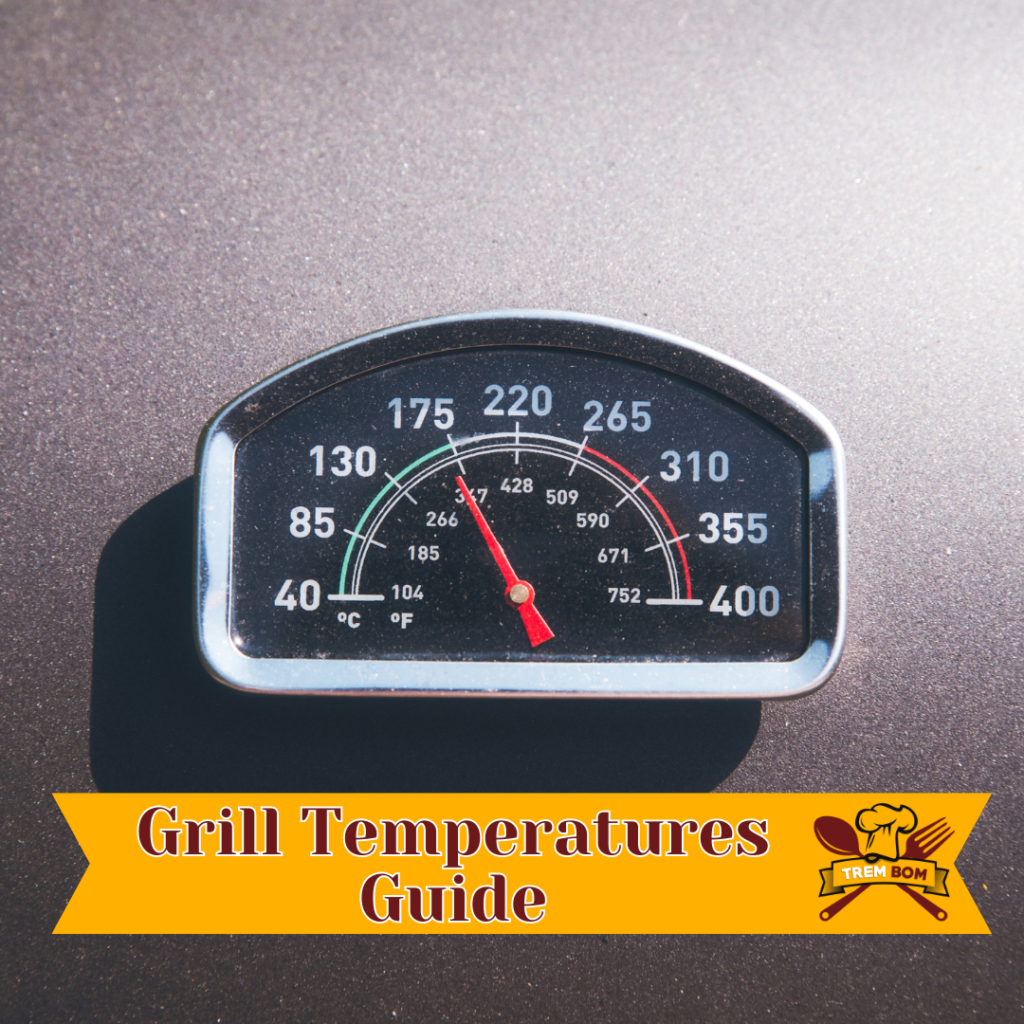
Grilling is an art that requires patience, practice, and the right temperature. Knowing the optimal temperature for different types of food is the key to achieving perfectly cooked, juicy meals every time you fire up your grill. Whether you’re a beginner or a seasoned griller, this comprehensive guide will cover everything you need to know about grill temperatures and cooking times. We’ll start by explaining why grill temperature matters and the different types of grills and temperature control methods available. Then, we’ll dive into the recommended temperature ranges for various types of food and provide tips on using a meat thermometer to accurately check the internal temperature of your meat. We’ll also cover direct and indirect grilling methods, practical tips and techniques for managing grill temperatures, and a handy cheat sheet for quick reference. By the end of this guide, you’ll be equipped with the knowledge and techniques necessary to master the art of grilling and impress your friends and family with delicious, perfectly cooked meals.
Key Takeaways
- Knowing the optimal grill temperature is essential for achieving perfectly cooked, juicy meals.
- There are various types of grills available, each with its own temperature control methods.
- Recommended temperature ranges vary depending on the type of food being grilled.
- A meat thermometer is an essential tool for accurately checking the internal temperature of your meat.
- Direct and indirect grilling methods are popular techniques for cooking different types of food.
Why Grill Temperature Matters
Grilling is an art that requires an understanding of the importance of grill temperature. The temperature at which you grill your meat plays a crucial role in determining the level of doneness and flavor of your food. Different meats and cuts require specific temperatures to achieve optimal results. It is essential to check the grill temperature regularly during the cooking process to ensure the internal temperature of the meat is sufficient to guarantee doneness.
Internal temperature is an important factor in determining the doneness of your meat. For example, beef steaks are typically cooked to a temperature of 130°F to 140°F for medium-rare and 145°F to 160°F for medium to well-done, respectively. Chicken and turkey need to be cooked to an internal temperature of 165°F to ensure they are fully cooked and safe to eat.
Checking the grill temperature is essential to avoid undercooking or overcooking your meat. One popular method of checking the temperature of your meat is by using a meat thermometer. By inserting a meat thermometer into the thickest part of the meat, you can check the internal temperature and determine if the meat is cooked through.
Mastering the art of grilling requires a keen understanding of grill temperature and how it affects the cooking process. With the right amount of heat, your meat will cook evenly and retain its juices, resulting in a flavorful and juicy meal that your family and friends will love.
Types of Grills and Temperature Control
There are several types of grills available, each with its own unique advantages and temperature control methods. The four most common types of grills are gas grills, charcoal grills, smokers, and electric grills.
Gas Grills: Gas grills are convenient and easy to use. They are powered by propane gas and can be started with a simple push of a button. Gas grills offer precise temperature control, allowing you to adjust the heat quickly and accurately. They are great for grilling meats, vegetables, and fruits and are perfect for those who want a quick and simple grilling experience.
Charcoal Grills: Charcoal grills are a classic option that provides unmatched flavor. They require more effort and time to set up and use, but their superior smoky taste and aroma make them worth the extra effort. Charcoal grills are ideal for slow cooking and smoking meats, but they can also be used for grilling vegetables and fruits. Their temperature is controlled by the amount of charcoal used, and the venting system regulates airflow which can alter temperature precision.
Smokers: Smokers are designed specifically for slow cooking and smoking meats. They come in several different types, including vertical, horizontal, and offset smokers. Smokers use wood smoke to add flavor to the food and are ideal for cooking large cuts of meat like brisket and pork shoulder. Their temperature is regulated by the amount and type of wood used, and the airflow within the smoker.
Electric Grills: Electric grills are ideal for those who want the convenience of a gas grill with the taste of a charcoal grill. Electric grills are easy to use and heat up quickly. They are ideal for grilling meats, vegetables, and fruits and offer precise temperature control. Their temperature is controlled by an electric heating element, with many models featuring a thermostat for accurate temperature readings.
No matter what type of grill you choose, using a grill thermometer is the best way to ensure accurate temperature readings. A grill thermometer allows you to monitor the temperature of the grill and adjust the heat as needed to achieve the ideal temperature for your specific grilling needs.
Temperature Ranges for Different Foods
Grilling different types of food requires specific temperature ranges to ensure optimal flavor and doneness. Here’s a breakdown of the ideal grill temperatures for common meats:
| Food | Ideal Temperature Range |
|---|---|
| Poultry (chicken, turkey) | 165°F – 175°F |
| Steak (medium-rare to well-done) | 130°F – 160°F |
| Roast (beef, pork, lamb) | 145°F – 180°F |
| Pork chops | 145°F – 160°F |
| Brisket | 195°F – 205°F |
| Chicken breast | 160°F – 165°F |
It’s important to note that the internal temperature of meat will continue to rise a few degrees after it’s removed from the grill. To prevent overcooking, aim to remove the meat from the grill when it’s a few degrees below the desired temperature and let it rest for a few minutes before serving. This will allow the juices to redistribute, resulting in a more tender and flavorful dish.
Keep in mind that the above temperature ranges are just guidelines; the ideal temperature for grilling a specific type of food may vary based on factors such as grill type, thickness of the meat, and personal preference. Experiment with different temperatures and cooking times to find out the perfect balance for your grilled food.
Mastering the proper temperature ranges for grilling different foods is a key step in becoming a grill master. By following our temperature guide and using a meat thermometer, you’ll be able to achieve perfectly cooked and juicy meals every time you fire up your grill.
Using a Meat Thermometer
A meat thermometer is an essential tool for any griller. It allows you to check the internal temperature of your meat to ensure that it has reached a safe temperature and is cooked to perfection.
How to Check the Temperature of the Meat
Insert the meat thermometer into the thickest part of the meat, making sure it’s not touching any bones or the cooking surface. Wait for the thermometer to register a steady temperature and check the temperature on the thermometer display.
Reaching the Internal Temperature
The internal temperature of the meat will vary depending on the type and cut of the meat. For example, beef, pork, and lamb are considered safe cooked to an internal temperature of 145°F (62.8°C), while poultry should be cooked to an internal temperature of 165°F (73.9°C).
Using a Food Thermometer
If you don’t have a meat thermometer, a food thermometer can also work. However, make sure to insert it into the thickest part of the meat, and always clean it before and after use to avoid contamination.
Checking the Internal Temperature
Always check the internal temperature of the meat before you take it off the grill. If it hasn’t reached the desired temperature, continue cooking until it does. This will ensure that the meat is cooked thoroughly and reduces the risk of undercooked food.
By using a meat thermometer and checking the internal temperature of your meat, you’ll be able to ensure that your food is cooked to perfection every time you grill.
Direct and Indirect Grilling Methods
Grilling is more than just slapping meat on the grill and calling it a day; it requires a bit of finesse and technique. Direct and indirect grilling are two popular methods that can be used to cook different types of food. Understanding the difference between these methods and when to use each one is key to becoming a grill master.
Direct Grilling
Direct grilling is the most common method of grilling. This method involves placing the food directly above the heat source, whether that be charcoal briquettes or propane flames. Direct grilling is best for cooking foods that are thin, tender, and cook quickly, such as burgers, hot dogs, and vegetables. To achieve the perfect sear, preheat your grill to high heat.
Indirect Grilling
Indirect grilling involves cooking food away from the direct heat source, using the heat from the sides or back of the grill. This method is ideal for larger cuts of meat, such as roasts and briskets, that require longer cooking times. Indirect grilling is also a great way to turn your grill into a smoker, infusing your food with delicious smoky flavors. To create indirect heat, simply place your charcoal briquettes on one side of the grill or turn off one of the burners on your gas grill.
Charcoal Briquettes or Propane?
Choosing between charcoal briquettes or propane is a matter of personal preference. Charcoal briquettes provide a smoky flavor and can reach high temperatures, making them ideal for direct grilling. Propane grills, on the other hand, are more convenient and offer precise temperature control, making them a great option for indirect grilling and cooking on the grill.
Whichever method you choose, be sure to gauge the temperature of your grill using a thermometer, and avoid lifting the lid too often, which can cause temperature fluctuations and extend the cooking time.
Grill Temperature Tips and Techniques
Mastering grill temperature is key to ensuring perfectly cooked, delicious food every time. Whether you’re grilling burgers, steaks, or veggies, knowing how to control the heat is crucial. Here are some tips and techniques to help you become a grill master:
Understanding Heat Settings
Many grills come with heat settings like high, medium, and low. It’s important to understand what the temperature range is for each setting on your grill. For example, high heat can reach temperatures between 450°F-550°F, while medium heat can range from 350°F-450°F. Knowing these temperature ranges will help you create the perfect cooking environment for your food.
Testing the Heat
One way to test your grill’s temperature is by holding your hand a few inches above the grates. If you can only hold your hand for a few seconds, the grill is at a high temperature. If you can hold your hand for 4-5 seconds, the temperature is medium-high. Holding your hand for 6-7 seconds means the grill is at medium heat, while 8-10 seconds indicates low heat.
Cleaning Your Grill
A clean grill is key to temperature control. Buildup of grease and debris can throw off the temperature and cause uneven heating. Make sure to clean your grill after each use, and during extended grilling sessions, clean the grates in between batches of food.
Creating Grill Marks
Grill marks not only look great, but they also add flavor to your food. To get perfect grill marks, preheat your grill to high heat. Once hot, place your food on the grates at a diagonal angle. After a few minutes, rotate the food to create crosshatch grill marks.
Indirect vs. Direct Heat
Direct heat is great for quick-cooking foods like vegetables and thinner cuts of meat. Indirect heat is better for slow-roasting larger cuts of meat like brisket or pork shoulder. Learn when to use each cooking method to make the most of your grill.
Using a Temperature Gauge
A temperature gauge is an essential tool for controlling grill heat. Make sure to place the gauge on the grill grates to get an accurate reading. You can adjust the temperature by adding or removing charcoal, opening or closing vents, or adjusting the gas flow.
With these tips and techniques, you’ll be able to master grill temperature and create perfectly cooked meals every time. Happy grilling!
Grill Temperatures Guide Cheat Sheet
Whether you’re grilling for a family BBQ, a dinner party or just cooking for yourself, having a handy cheat sheet with key temperatures for various meats and popular grilled foods can make cooking much easier. It can help you gauge the ideal grill temperature and cooking times so you can cook your food to perfection. Below, you’ll find a useful cheat sheet for your grilling needs:
| Food Cooked | Temperature Range | Time You Want |
|---|---|---|
| Beef (steak, roast, brisket) | 125-160°F (52-71°C) | 1-3 hours |
| Poultry (chicken breast, whole chicken, turkey) | 165-180°F (74-82°C) | 1-2 hours |
| Pork (chops, loin, roast) | 145-160°F (63-71°C) | 1-2 hours |
| Fish (salmon, halibut, tuna) | 125-145°F (52-63°C) | 10-15 minutes |
| Small or high moisture vegetables (asparagus, zucchini, mushrooms) | 350-400°F (177-204°C) | 10-15 minutes |
| High moisture vegetables or fruit (peaches, pineapple, watermelon) | 300-350°F (149-177°C) | 5-10 minutes |
It’s important to note that these are recommended temperature ranges and times. To find out the perfect temperature and cook time for your specific grill and desired level of doneness, use a meat thermometer to check the internal temperature of your food. Additionally, always prioritize food safety by ensuring your food is cooked thoroughly before serving.
Conclusion
Grilling is not just about cooking food; it’s about creating a mouthwatering experience that tantalizes your taste buds. By mastering grill temperatures and cooking times, you can achieve perfectly cooked meals every time you fire up your grill. Whether you prefer to grill with pellet, charcoal, or wood, knowing the right temperatures for different meats and cuts is essential to achieving that perfect meat flavor and juiciness. And let’s not forget about the veggies! Small or high moisture vegetables, as well as high moisture fruits, also require specific temperatures to cook to perfection. By following the tips and techniques in this guide, you’ve now mastered the art of grilling. You can experiment with different temperatures, cooking times, and even direct and indirect heat methods to create unique and tasty dishes. So get your grill ready, gather some friends and family, and enjoy the amazing flavors of perfectly cooked grilled food. And remember, whether you prefer celsius or fahrenheit, the key is to master the grill temperatures and techniques to achieve the perfect grilled meal every time.
FAQ
What is the importance of grill temperature?
Grill temperature is crucial in determining the doneness and flavor of your food. Different meats and cuts require specific temperatures for optimal results.
What are the different types of grills and temperature control methods?
There are various types of grills, including gas grills, charcoal grills, smokers, and electric grills. Each has its own advantages and temperature control methods.
What are the recommended temperature ranges for different foods?
The recommended temperature ranges vary depending on the type of food. Poultry, steaks, roasts, pork chops, and chicken breasts all have specific ideal temperatures for desired doneness.
How do I use a meat thermometer?
A meat thermometer is a vital tool for grilling. Learn how to properly check the internal temperature of your meat and understand the recommended temperatures for different types of meat.
What are direct and indirect grilling methods?
Direct and indirect grilling are two popular methods used to cook different types of food. Understand the differences between these methods and when to use each.
What are some tips and techniques for managing grill temperatures?
This section provides practical tips and techniques for managing grill temperatures. Learn how to gauge the heat, create perfect grill marks, and keep your grill clean for optimal temperature control.
Where can I find a grill temperatures guide cheat sheet?
We provide a handy cheat sheet with key temperatures for various types of meat and popular grilled foods. This cheat sheet serves as a quick reference guide for gauging the ideal grill temperature and cooking times.






